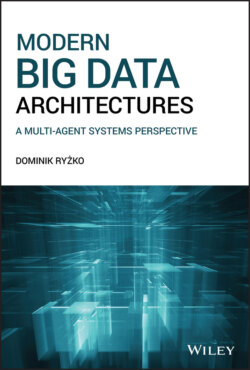Читать книгу Modern Big Data Architectures - Dominik Ryzko - Страница 8
CHAPTER 1 Introduction 1.1 Motivation
ОглавлениеIn recent years, big data has emerged as one of the leading trends not only in computer science, but due to its potential, also in economy, science, and major branches of the industry. People realized that huge data sets have become a key asset which should be taken into account in evaluating business opportunities, company valuations, or product development. Several major mergers and acquisitions in recent years have been driven not only in order to gain synergies, customer base, or market access, but also to obtain access to valuable customer data. For example, Microsoft's acquisition of Linkedin gave it data on jobs, skills, career paths, and a contact network of millions of workers across the globe.
For technology vendors, consultancies as well as numerous startups, this rapid growth opened up huge new business opportunities. According to IDC, the market value of big data and business analytics is expected to grow beyond $200 Billion by the year 2020. Forbes [2017]. These forecasts have fueled huge investments in big data related research and development efforts, both in academia and in industry, leading to a wide range of proposed architectures, solutions, models, algorithms, as well as commercial products.
Large industry players have made the big data concept fundamental to their products, architectures, and strategies. Every day, new ventures emerge which concentrate solely on big data as an opportunity for innovation and growth. Those who failed to follow the trend early see the rising competition and disruption, even in well established and heavily regulated industries such as banking or insurance, as can be observed by the growing number of fintech and insurtech ventures.
Academia has been intensively updating curricula to educate the next generation of data scientists, big data engineers, DevOps, etc. The research areas and goals of computer science departments have followed suit. New dedicated MOOCs (Massive Online Open Courses) become available every month and gather thousands of attendants. The number of conference tracks and entirely new events around the subjects of analytics and processing of big data is growing rapidly each year.
While there is no single agreed on definition of big data, it is commonly regarded as a general move towards analytics and applications, which rely heavily on processing of extremely large data sets in order to provide intelligent, personalized services to the users and other services in the ecosystem. This trend has been largely supported by recent advances in parallel computing architectures, emergence of NoSQL databases, cloud computing technologies and continuous improvements in machine learning and other branches of Artificial Intelligence (AI).
Multi-Agent Systems (MAS) use the concept of the agent as a central entity for building systems. This is often confusing as the term is heavily overloaded even within computer science, not to mention its use in multiple other disciplines such as economy, sociology, cognitive science, etc. MAS however iterates specifically the properties an agent should implement. It should be autonomous, understood as making its own decision based on internal state, goals, and observations. An agent should be proactive, so it should act when it believes it is appropriate not only when explicitly called. Finally, it should be intelligent in the AI sense of intelligence, therefore capable of solving complex tasks and learning by past experiences. Building on such components, MAS tries to assemble complex systems in which agents communicate asynchronously and collaboratively solve given tasks.
Even though MAS emerged as a separate field of research much earlier than big data, it failed to achieve such wide adoption and popularity. We can identify several reasons for this. One is that, until recently, there were no advanced and mature architectures for efficient distributed asynchronous processing. Only in the last decade the limitations to Moore's Law increased the efforts towards parallel computations. Another reason is the radical approach to the distribution of control in MAS. Agents were proposed as highly independent, autonomous, proactive entities communicating with the use of “soft” protocols, e.g. negotiation, argumentation etc. These assumptions were not in line with available means for monitoring of such systems, and so were unacceptable for several practical industry applications, where strict control and risk minimization are key, e.g. energy grid management, financial systems, traffic monitoring, etc.
This publication argues that the fields of big data and MAS have a lot in common. If we track the evolution of the IT systems from monolith, through SOA to microservices and most recently cyber-physical systems, we can see that the elementary system components more and more resemble agents as proposed many decades back. We rely more and more on loosely-coupled components centered around some well defined functionality and capable of autonomous and flexible operations even if other components fail or are temporarily out of reach. Now that distributed, cloud based computing has become standard, database paradigms have shifted from a strict transactional approach and physical objects obtain built-in intelligence, MAS approach no longer looks radical and unfeasible.
It seems we have arrived at the point where several research results achieved in both fields can be combined and benefit from cross-fertilization of ideas, tools, and architectures. Mobile agents for sensor networks can be applied for real time analytics in the fast growing area of the Internet of Things (IoT). Distributed machine learning algorithms can be coordinated with multi-agent cooperation protocols. Mobile and IoT cloud computing environments experience challenges related to resources and latency similar to the ones present in MAS especially for mobile agents.
On the other hand, modern big data environments offer unprecedented possibilities of performing large scale computations both in batch and streaming mode, which can greatly enhance capabilities of MAS. Cloud resources supporting mobile and IoT devices might well be used to empower intelligent agents located in the environment. On the lower level, modern distributed programming libraries (e.g. Scala Akka) can greatly improve performance of MAS, which often use less advanced environments, not capable of efficient thread and resource management.
